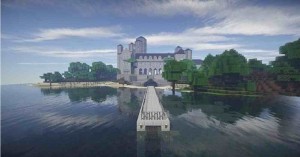Dear reader, here for your apprecciation, another piece from our roving U.S correspondent Cecil.
I’m enjoying a Gatsby like sojourn in an immense Lake House, ninety minutes drive south west of Chicago. Numerous flat screens, even in the lavish bathrooms, plus a large digital projector. 12 bedrooms, three ovens, six refrigerators. Boat house, summer house, ski boat, pontoon boat, kyaks, floating island. Spa, artificial beach, waterfall. The lake has beautiful fresh clear water. Trees and thick vegetation line the many tongued lake. Houses, like the one we are staying at, are spread along the shoreline.  We take the pontoon boat out with six adults, and five kids, picnic in one of the arms, with lots of swimming and skylarking, lazing and reading.
We take the pontoon boat out with six adults, and five kids, picnic in one of the arms, with lots of swimming and skylarking, lazing and reading.
I get to wondering about this lake, its origins, its geomorphology. The lake sits near a major water shed, one side feeding into the Mississippi and out into the Gulf of Mexico, the other into Lake Michigan and on into the St Laurence River and out into the North Atlantic near Nova Scotia. The watershed is almost flat, and in earlier times water flowed either way, depending on rainfall and water levels.
It is true (disclaimer here: I do not know that this is true) that there are fourteen minerals essential for human life, (and I am lead to believe that wine has all fourteen), and I reckon the water in this lake had quite a number of minerals and maybe a few that were not quite so essential. In fact the water may not be quite as beautiful, clear and fresh as I at first supposed, for this lake is actually a re-purposed strip mine, a mine that provided companies like Peabody Energy glorious profits from the sale of the coal mined here.
(Of course the vast bulk of Coal companies in the US have filed for Chapter 11 Bankruptcy Protection, although Peabody Energy has excluded its Australian operations from the suit, a nod, no doubt, to the significant ethical moral and financial support offered the Coal Industry by the Australian people through its benevolent Government.)
So here we are in a re-purposed coal mine, re-purposed to support the real estate industry.
From this idyll we visited another example of re-purposing, of reclamation, of adaptive re-use. The Midewin National Tallgrass Prarie was until recently a munitions plant, part of the Joliet Army Ammunition Plant. Over 5000 Hectares are now open to the public and are replanted as Tallgrass Prarie. Bison have been re-introduced as part of the plan. The vegetation is varied and dense. Mainly perennial, it dies off in the Autumn before the winter freeze. Regular burning is likely to be an ongoing part of the management plan. The volume of herbage is quite extraordinary, certainly by Australian standards.
These two reclamations, the coal mine/lake and the munitions factory/prarie are surrounded either by fields planted with corn or soy bean, farmed by people whose only nod to wealth is in their shiny new green or red farming plant, never in their houses, or by chemical plants belching forth smoke, with their owners shielded from public view behind pension funds, merchant bankers and the like.
This is a strange country. Much like Australia.



